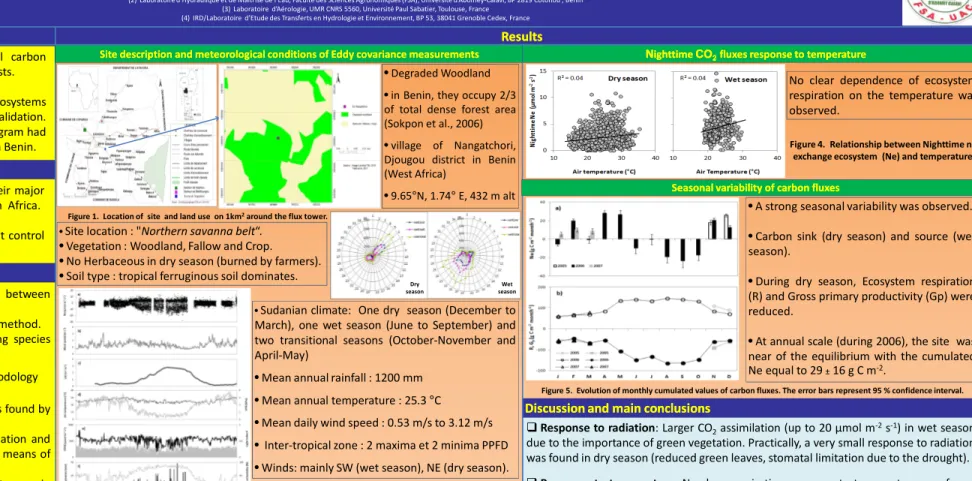Diurnal and seasonal variability of CO
2fluxes over a degraded Woodland under a Sudanian climate in Northern Benin, West Africa
Expédit Evariste Ago1,2, Dominique Serça3, Euloge Kossi Agbossou2, Sylvie Galle4and Marc Aubinet1(1) Axe Exchanges Ecosystems-Atmosphere, Department Biosystem Engineering (BIOSE), Gembloux Agro-Bio Tech, University of Liege, 2 Passage des Déportés, 5030 Gembloux, Belgium (eeago@doct.ulg.ac.be) (2) Laboratoire d’Hydraulique et de Maîtrise de l’Eau, Faculté des Sciences Agronomiques (FSA), Université d’Abomey-Calavi, BP 2819 Cotonou , Benin
(3) Laboratoire d’Aérologie, UMR CNRS 5560, Université Paul Sabatier, Toulouse, France (4) IRD/Laboratoire d’Etude des Transferts en Hydrologie et Environnement, BP 53, 38041 Grenoble Cedex, France
Objectives of
Objectives of thisthis studystudy
Methods Methods
→to estimate the net ecosystem exchange and their major components of a Sub-Saharan Woodland in Western Africa. → to determine some mechanisms and factors that control the daytime and nighttime fluxes in the Woodland.
- Measurement period : Seventeen (17) months between November 2005 and March 2007
- CO2and H2O fluxes measured by eddy-covariance method.
- Micrometeorological measurements & dominating species inventory around the fluxes tower (1kmx1km).
Introduction Introduction
High uncertainties remain on Africa’s terrestrial carbon budget, especially on African’s Woodlands and Forests. Models simulating carbon dynamics in terrestrial ecosystems need site level measurements for calibration and validation. With this goal, the AMMA-CATCH International program had
installed few flux towers in West Africa, especially in Benin. Figure 4. Relationship between Nighttime net
exchange ecosystem (Ne) and temperature .
Results Results •Degraded Woodland
•in Benin, they occupy 2/3 of total dense forest area (Sokpon et al., 2006)
•village of Nangatchori, Djougou district in Benin (West Africa)
•9.65°N, 1.74°E, 432 m alt
N
NighttimeighttimeCOCO22fluxes response to temperaturefluxes response to temperature
•A strong seasonal variability was observed.
•Carbon sink (dry season) and source (wet season).
•During dry season, Ecosystem respiration (R) and Gross primary productivity (Gp) were reduced.
•At annual scale (during 2006), the site was
Site description and meteorological conditions of Eddy covariance measurements Site description and meteorological conditions of Eddy covariance measurements
•Site location : "Northern savanna belt“.
•Vegetation : Woodland, Fallow and Crop.
•No Herbaceous in dry season (burned by farmers).
•Soil type : tropical ferruginous soil dominates.
•Sudanian climate: One dry season (December to March), one wet season (June to September) and two transitional seasons (October-November and
Figure 1. Location of site and land use on 1km2around the flux tower.
Wet season Dry
season
No clear dependence of ecosystem respiration on the temperature was observed.
Seasonal
Seasonal variabilityvariability of of carboncarbon fluxesfluxes
Axe Exchanges Ecosystems-Atmosphere
inventory around the fluxes tower (1kmx1km).
•Different responses according to the season: in wet season, CO2assimilation increases
with radiation increasing (Qp) following a typical curvilinear function while in dry season,
very small response of CO2 flux increases to Qp due to the small density of green
vegetation.
•Saturation was observed for Qp> 1000 µmol m-2s-1
Acknowledgements Acknowledgements
This work was financed by “Agence Belge de Développement” (CTB) and “Association pour l’Agriculture et le Développement Durable” (A2D). We thank also members of AMMA-CATCH Benin program for supplying Eddy-covariance and complementary micrometeorological data set.
Discussion and main conclusions Discussion and main conclusions
Response to radiation: Larger CO2assimilation (up to 20 µmol m-2s-1) in wet season
due to the importance of green vegetation. Practically, a very small response to radiation was found in dry season (reduced green leaves, stomatal limitation due to the drought).
Response to temperature: No clear respiration response to temperature was found
probably because it was masked by the response to soil moisture or the respiration was insensitive to the temperature range at this region?
Seasonal variability: A strong variability of carbon fluxes were observed due to the
alternation between dry and wet seasons.
Annual pattern : The site was near the equilibrium concerning the carbon exchanges
with the atmosphere probably due to the high disturbance by local populations through the agricultural activities, fire, gazing and illegal trees logging.
- All data treated following standard methodology (Aubinet et al., 2012).
Figure 3. Diurnal course of net exchange ecosystem (Ne) and response to radiation. The error bars represent 95 % confidence interval. Diurnal course of CO
Diurnal course of CO22fluxes and response to radiation (Qfluxes and response to radiation (Qpp))
European Geosciences Union (EGU) General Assembly, Vienna , Austria, 12-17 April 2015
•At annual scale (during 2006), the site was near of the equilibrium with the cumulated Ne equal to 29 ± 16 g C m-2.
- Nighttime CO2 flux correction, u* threshold 0.10 as found by (Ago et al., 2014).
- Daytime gaps were filled using the Misterlich equation and Nighttime gaps using the relationship with the daily means of relative humidity (RH)
-Flux-partitioning was performed into Gp and R, the two main components (Gilmanov et al., 2013, 2010)
Figure 2. Mean daily meteorological conditions at the Djougou region and CO2fluxes overview.
two transitional seasons (October-November and April-May)
•Mean annual rainfall : 1200 mm
•Mean annual temperature : 25.3°C
•Mean daily wind speed : 0.53 m/s to 3.12 m/s
• Inter-tropical zone : 2 maxima et 2 minima PPFD
•Winds: mainly SW (wet season), NE (dry season).
